Talk to a Registered Dietitian and use INSIDER20 for 20% off!
Talk to a real Dietitian for only $99: Schedule Now
This post contains links through which we may earn a small commission should you make a purchase from a brand. This in no way affects our ability to objectively critique the products and brands we review.
Evidence Based Research To fulfill our commitment to bringing our audience accurate and insightful content, our expert writers and medical reviewers rely on carefully curated research.
Read Our Editorial Policy
Although olive oil has only become a staple ingredient in American kitchens since around the 1990s, people in the Mediterranean regions have been using olive oil for thousands of years.
With ancient uses ranging from culinary and cosmetic to medicinal and monetary—it was used for bartering and currency back in the day—it’s no wonder that olive oil’s nickname is “liquid gold.”
However, the modern olive oil industry is rife with problems, including adulteration with lower-quality oils, mislabeling, rancidity, and fraud.
These issues make it hard to know which olive oils are best—and when you add in terms like virgin, extra-virgin, cold-pressed, cold-extracted, refined, unrefined, and so on, buying olive oil becomes downright confusing.
Fortunately, many brands are fighting back on these problems, producing higher-quality olive oils with wide-open transparency about sourcing, farming, and manufacturing.
In this article, check out our list of the eight best olive oils, including our top pick for everyday use, La Tourangelle Organic Extra Virgin Olive Oil, the best choices for cooking, baking, or drizzling, and options for budget, premium, flavored, and longer-lasting oils.
Best Overall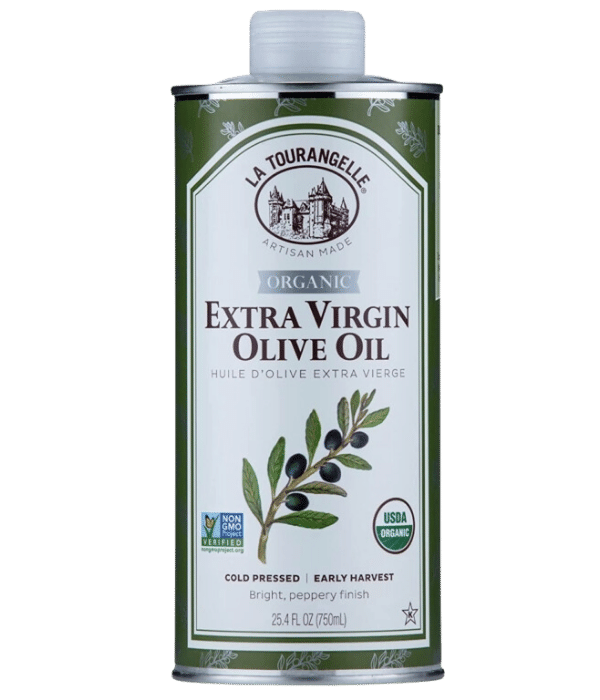 | for Cooking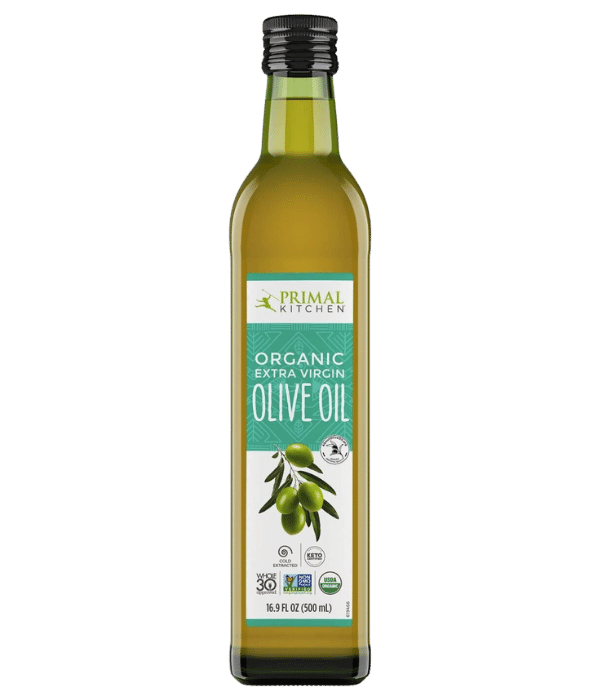 | for Dipping, Drizzling, and Dressing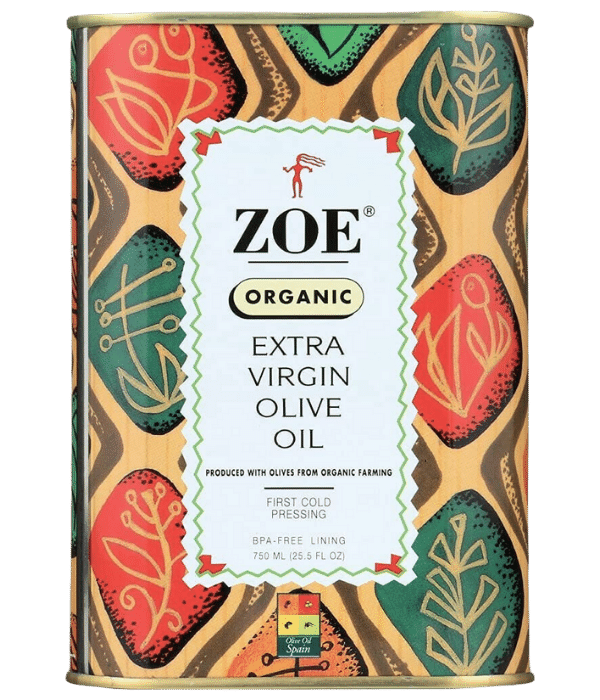 | |
|---|---|---|---|
| Product | La Tourangelle | Primal Kitchen | Zoe |
| Key Points | High antioxidant content; Good for use at all temperatures; Affordable; Processed shortly after harvest; Aluminum can prevents oxidation; High transparency with sourcing. | Good for cooking with; Cold-extracted process; Certified Organic, Whole30 Approved®, Certified Paleo, Keto Certified, Non-GMO Project Verified, and NAOOA Certified. | Best for drizzling, dipping, and dressing; High transparency about sourcing (first cold press of hand-selected Cornicabra olives from the groves of Castilla-LaMancha, Spain), Eco-Cert Organic Certification. |
| Cost | $17.99 for 25.5oz ($0.70/oz) Shop Now | $13.49 for 16.9oz ($0.80/oz) Shop Now | $30.65 for 25.5oz ($1.20/oz) Shop Now |
Best for: Everyday use at all temperatures, including cooking, baking, or finishing.
As our top pick for everyday use, La Tourangelle Organic Extra Virgin Olive Oil is an excellent choice for all forms of cooking, including sauteing, baking, dressing, or finishing.
La Tourangelle uses olives from Puente de Genave, a region within the Natural Park of the Sierra de Segura in Spain, which is a somewhat stressful environment for the olives to grow in.
While this doesn’t sound good, it actually makes the olives develop more antioxidants to fight the stress, making this olive oil higher in oleic acid—the primary antioxidant found in olives.
This olive oil is also higher in antioxidants because La Tourangelle processes the olives shortly after harvesting, uses a molecular distillation process that minimizes heat, and stores them in an aluminum can to prevent oxidation.
As it’s higher in antioxidants and oleic acid, this olive oil is more stable and has a higher smoke point (up to 410°F)—therefore, it’s able to be used at higher temperatures than many other olive oils.
Lastly, this affordable olive oil is well-balanced, bright, and fruity, making it an ideal choice for many foods.
Best for: Medium-heat, everyday cooking at an affordable price.
Primal Kitchen Organic Extra Virgin Olive Oil is a great option for sauteing or cooking foods over medium heat—as Primal Kitchen puts it, you can “Drizzle, sizzle, dunk, and dress!”
We like that this olive oil is affordable, at $0.80 per ounce, and has a mild flavor that works well with most meals.
Primal Kitchen’s olive oil is also Certified Organic, Whole30 Approved®, Certified Paleo, Keto Certified, Non-GMO Project Verified, and NAOOA Certified.
The North American Olive Oil Association (NAOOA) conducts testing and certification for olive oils in the U.S. and Canada, testing multiple times per year for adherence to the physicochemical standards set by the International Olive Council (IOC) for both purity and quality.
However, while other olive oil brands delve deep into where their olives are sourced from and how they are processed, we just know two things about Primal Kitchen’s olive oil—the olives come from Tunisia and Spain, and they are cold-extracted.
As a quick aside, cold-extracting is different than cold-pressing.
While neither is heated above 80°F during processing, cold extraction is a newer process that obtains the olive oil with a centrifuge, while cold pressing is the traditional method that uses two presses to separate out the oil from the olives.
Overall, Primal Kitchen provides one of the best extra virgin olive oils for cooking at an affordable price.
Best for: Using atop finished meals or no-heat cooking, including salad dressings, drizzling as a finisher, or dipping with bread.
With a fruity, buttery, and peppery flavor, Zoe Organic Extra Virgin Olive Oil is best used for dressing, drizzling, and dipping.
This olive oil comes from the first cold press of hand-selected Cornicabra olives from the groves of Castilla-LaMancha, Spain.
Zoe also has an Eco-Cert Organic Certification to ensure no chemicals, pesticides, or additives are used during any part of the growing, harvesting, or pressing process.
While this olive oil is on the expensive side, at $1.20 per ounce, you’ll likely use less of it if you’re using it to finish a meal or drizzle on top.
Best for: Using in baked good recipes, including bread, cakes, cookies, and more.
Good olive oils for baking tend to have a mild, lightly buttery flavor that can withstand moderate temperatures—and California Olive Ranch, Global Blend Mild Extra Virgin Olive Oil fits the bill.
Many regions of California have a similar climate to the Mediterranean, allowing farms like California Olive Ranch to thrive—even winning them over 230 awards in the U.S. during the two decades they’ve been around.
However, California Olive Ranch has branched out from solely sourcing from the Golden State, as their Global Line also features olive oils from Argentina, Portugal, and Chile.
Although some people prefer single-origin olive oils, we loved that California Olive Ranch bottles now feature QR codes that provide the exact percentage of all regions for that product, plus chemistry data on the quality and nutrition of the oil.
We also picked this olive oil because it’s affordable, certified by the Olive Oil Commission of California, and has a top-rated taste that lends itself to everything from baking sourdough to making salad dressing.
Best for: People who go through a lot of olive oil; people wanting an affordably priced olive oil that still has good quality.
For bulk buyers with a Costco card, Kirkland Signature Organic Extra Virgin Olive Oil provides you with a lot of bang for your buck at just $0.41 per ounce.
While this olive oil certainly isn’t as fancy as others on this list, it still is organic, extra-virgin, and sourced from Mediterranean olives.
However, we don’t get too many details about sourcing and manufacturing—they just state that the olives come from Portugal, Tunisia, Italy, and Greece.
Another downside is that this olive oil comes in a plastic bottle, which is not the best for olive oil storage—although it is dark green, which helps to prevent oxidation from light exposure.
Best for: People wanting a top-of-the-line olive oil; For use as a finishing oil.
For the foodies and olive oil experts, Pianogrillo Farm Extra Virgin Olive Oil is a premium olive oil with a premium price to match.
Pianogrillo olive oil is produced organically by Lorenzo Piccione in the town of Chiaramonte Gulfi, in the province of Ragusa in Sicily, from a local olive variety called Tonda Ible.
The olives are individually hand-picked and harvested at the beginning of the season, ensuring peak freshness and maturity before being processed at the family-owned mill in Italy.
This Sicilian olive oil is best used as a finishing or drizzling oil (rather than for cooking) and provides a delicate balance between fruitiness and spiciness.
Best for: People wanting a premium flavored or infused olive oil; Those wanting to give olive oil as a gift or display it as a form of art in the kitchen.
If you’re looking for a beautiful bottle of deliciously flavored olive oil, Brightland Cold-Pressed Olive Oil is your best bet.
In this four-pack, you’ll find chili-, garlic-, lemon-, and basil-infused oils, all of which are cold-pressed within 90 minutes of harvest and sourced from small family farms in California.
In contrast to many other “infused” oils that only use natural flavors, these oils use the real deal.
For example, the Ardor chili oil adds hot pepper oil extract, chipotle extract, paprika oil extract, and jalapeno oil extract to their extra virgin olive oil, while the Arise basil oil is solely Arbosana olives and basil.
However, at almost $3 per ounce, these oils are not inexpensive, and therefore likely not for everyday use—special occasion drizzling only!
Best for: People who don’t go through olive oil quickly; Using as a finishing olive oil.
Lastly, a great option for those who aren’t guzzling olive oil every day, Gaea Greek Fresh Special Reserve Extra Virgin Olive Oil is designed to last 30 months from its harvest date.
With olives grown and hand-picked from the Northwestern Peloponnese region of Greece, this is a special reserve, first-harvest olive oil with high polyphenol levels.
After handpicking, Gaea uses advanced technology that crushes the olives for three hours, sealing in aromas and freshness and keeping it protected from light, heat, and oxygen.
These methods allow this olive oil to last longer than most—especially if you store it in a cool, dark place (as you should all olive oil).
With its low acidity and fresh, fruity flavor, Gaea recommends that this oil be used for salad dressings or dipping bread in, not high-heat cooking.
There are many great brands of olive oil, including La Tourangelle, Primal Kitchen, Zoe Organic, California Olive Ranch, Pianogrillo, Brightland, and Gaea.
The best one for you depends on your needs.
Extra virgin olive oil means that the oil comes from the first pressing of olives.
Extra virgin and virgin olive differ based on their acidity—it can be called extra virgin if the free fatty acid level is 0.8% or lower, while virgin olive oil can have a fatty acid level between 0.8-2.0%.
Time—including time spent on the tree after maturity and time between harvesting and processing—can increase its acidity.
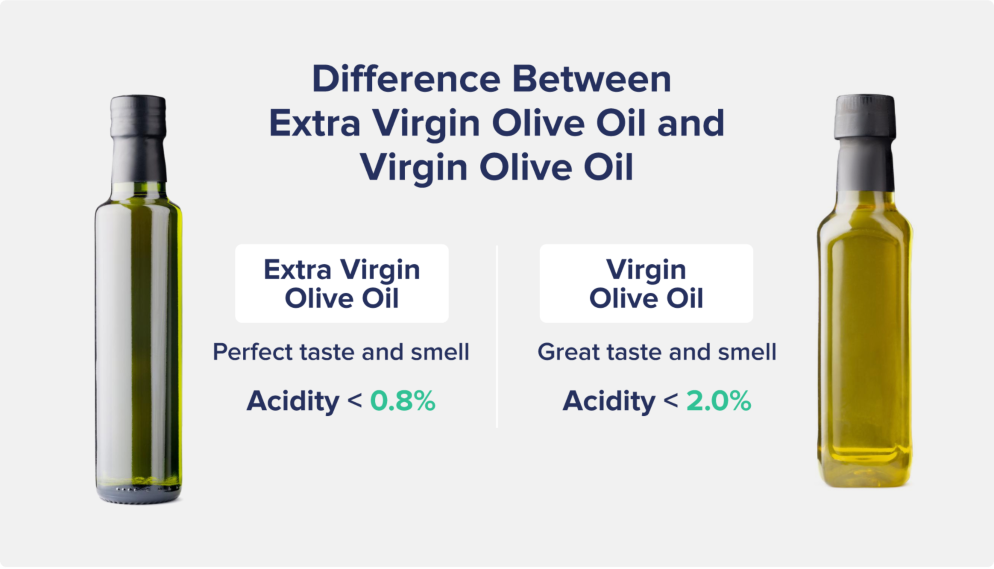
Costco (Kirkland) olive oil is a good option for people on a budget or who want a bulk container of olive oil.
The Kirkland brand carries organic and extra-virgin olive oil options.
You can tell olive oil is good quality if it is extra-virgin, cold-pressed or cold-extracted, organic, has certifications, is in a dark bottle, and states the country (or countries) of origin.
Bonus points if the bottle states the harvest date.
According to Matthieu Kohlmeyer, Founder and CEO of La Tourangelle, olive oil of the highest quality also has excellent flavor and should taste peppery on the back of your throat.
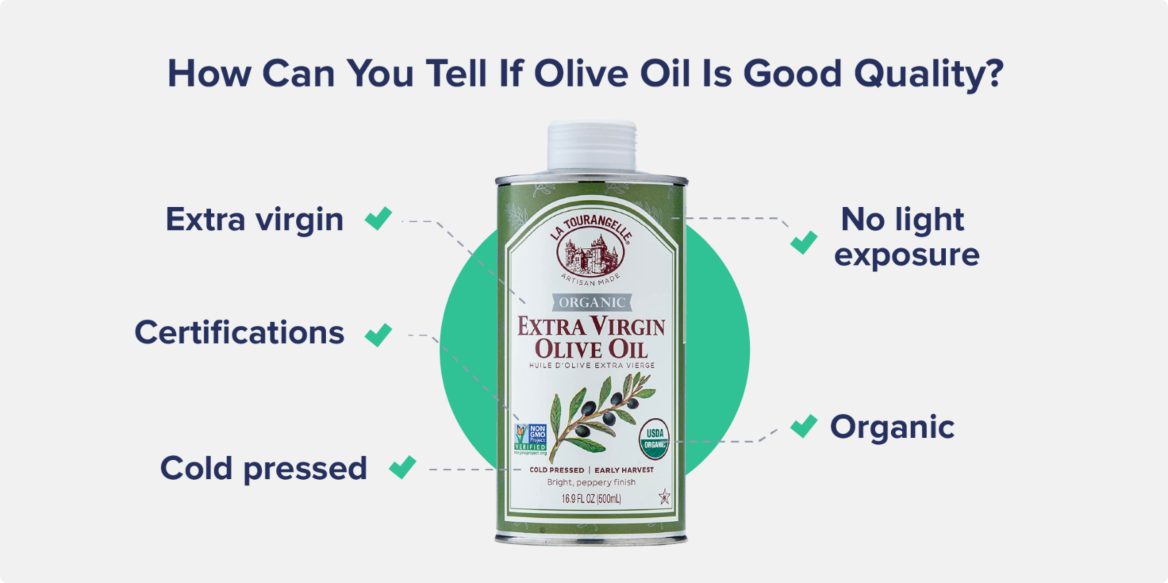
Extra-virgin olive oil is the healthiest type of olive oil, as it preserves antioxidants and nutrients.
Extra-virgin olive oil is the purest form of olive oil available, as there are strict standards for calling oil extra-virgin.
These standards include unadulterated oil from olives that did not use chemicals or heat to extract the oil and a free fatty acid content of less than 0.08%.
High-quality extra-virgin olive oils have higher amounts of antioxidants that protect the oil from heat during cooking, leading to smoke points of around 410°F.
According to the North American Olive Oil Association, the smoke point of some olive oils can even be as high as 470°F.